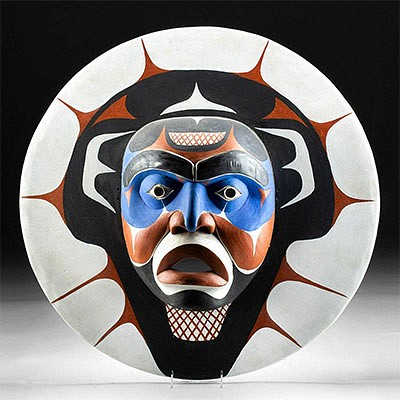Mixtec Pottery Tripod Strainer w/ Quetzalcoatl Insignia
Lot 38a
About Seller
Artemis Fine Arts
686 S Taylor Ave, Ste 106
Louisville, CO 80027
United States
Selling antiquities, ancient and ethnographic art online since 1993, Artemis Gallery specializes in Classical Antiquities (Egyptian, Greek, Roman, Near Eastern), Asian, Pre-Columbian, African / Tribal / Oceanographic art. Our extensive inventory includes pottery, stone, metal, wood, glass and textil...Read more
Categories
Estimate:
$900 - $1,300
Absentee vs Live bid
Two ways to bid:
- Leave a max absentee bid and the platform will bid on your behalf up to your maximum bid during the live auction.
- Bid live during the auction and your bids will be submitted real-time to the auctioneer.
Bid Increments
| Price | Bid Increment |
|---|---|
| $0 | $25 |
| $300 | $50 |
| $1,000 | $100 |
| $2,000 | $250 |
| $5,000 | $500 |
| $10,000 | $1,000 |
| $20,000 | $2,500 |
| $50,000 | $5,000 |
| $100,000 | $10,000 |
| $200,000 | $20,000 |
About Auction
By Artemis Fine Arts
Mar 18, 2021
Set Reminder
2021-03-18 10:00:00
2021-03-18 10:00:00
America/New_York
Bidsquare
Bidsquare : Pre-Columbian | Tribal | Oceanic
https://www.bidsquare.com/auctions/artemis-gallery/pre-columbian-tribal-oceanic-6520
Featuring Pre-Columbian, Native American, African / Tribal, Oceanic, much more. All items have been legally acquired and are legal to sell. Convenient in-house shipping. Artemis Fine Arts info@artemisfinearts.com
Featuring Pre-Columbian, Native American, African / Tribal, Oceanic, much more. All items have been legally acquired and are legal to sell. Convenient in-house shipping. Artemis Fine Arts info@artemisfinearts.com
- Lot Description
Pre-Columbian, Valley of Mexico, Mixtec people, ca. 1200 to 1500 CE. A pottery strainer featuring a broad, circular rim atop a shallow basin that stands on three slender, rectangular feet. A starfish-like motif with an interior volute, known as the ehecailacocozcatl, is painted in black at the center of the platter and is surrounded by five evenly spaced drill holes, which allow the dish to drain liquid. Maze-like vibrant orange and black painted motifs against a taupe slip form a patterned border around the rim of this wonderful example, while vertical and horizontal black striations on an orange ground decorate the outer face of each leg. The ehecailacocozcatl ("wind breastplate" or in Nahuatl "spirally voluted wind jewel") is the insignia of Quetzalcoatl, the Mesoamerican god of wind and learning, and is formed by cutting across the upper portion of a conch shell (Strombus gallus). These emblems were traditionally reserved from sculptures of Quetzalcoatl and high priests, who were considered his earthly representatives, suggesting that this strainer may have served a ceremonial purpose. Size: 10.5" in diameter x 3.75" H (26.7 cm x 9.5 cm)
Quetzalcoatl - "Feathered Serpent" in the Nahuatl language - is the Pre-Columbian deity revered as lord of wind and sky. The earliest representations of Quetzalcoatl adorn the Temple of Quetzalcoatl in Teotihuacan, Mexico (ca. 3rd century CE) where numerous stone heads of the divine plumed snake embellish the steps of this Pre-Classic pyramid. The pioneering artist/anthropologist Miguel Covarrubias whose writings and illustrations on indigenous cultures of the ancient Americas continue to contribute to scholarly studies today stated, "Quetzalcoatl stood for all that was good in this world: peace, art, wisdom, and prosperity. Disguised as an ant, he discovered maize, the staple food of the Indians, hidden under the mountain of Substance, Tonacatepetl; he also invented the arts, the sciences, and the calendar. In fact, everything connected with wisdom and culture was attributed to Quetzalcoatl." (Miguel Covarrubias, Mexico South: The Isthmus of Tehuantepec (New York: Alfred A. Knopf, 1946), 130.
Provenance: ex-old private New England collection, acquired in the 1970s; ex-private New York, USA collection
All items legal to buy/sell under U.S. Statute covering cultural patrimony Code 2600, CHAPTER 14, and are guaranteed to be as described or your money back.
A Certificate of Authenticity will accompany all winning bids.
We ship worldwide and handle all shipping in-house for your convenience.
#161295Repaired from three pieces with restoration along break lines that is nearly invisible. Expected light scratches and pitting in a few small areas commensurate with age. Otherwise, excellent with impressive remaining pigments and lovely earthen deposits.Condition
- Shipping Info
-
All shipping is handled in-house for your convenience. Your invoice from Artemis Gallery will include shipping calculation instructions. If in doubt, please inquire BEFORE bidding for estimated shipping costs for individual items.
-
- Buyer's Premium



 EUR
EUR CAD
CAD AUD
AUD GBP
GBP MXN
MXN HKD
HKD CNY
CNY MYR
MYR SEK
SEK SGD
SGD CHF
CHF THB
THB

















